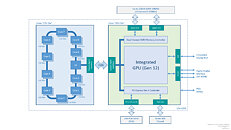- Joined
- Oct 9, 2007
- Messages
- 47,604 (7.45/day)
- Location
- Dublin, Ireland
| System Name | RBMK-1000 |
|---|---|
| Processor | AMD Ryzen 7 5700G |
| Motherboard | Gigabyte B550 AORUS Elite V2 |
| Cooling | DeepCool Gammax L240 V2 |
| Memory | 2x 16GB DDR4-3200 |
| Video Card(s) | Galax RTX 4070 Ti EX |
| Storage | Samsung 990 1TB |
| Display(s) | BenQ 1440p 60 Hz 27-inch |
| Case | Corsair Carbide 100R |
| Audio Device(s) | ASUS SupremeFX S1220A |
| Power Supply | Cooler Master MWE Gold 650W |
| Mouse | ASUS ROG Strix Impact |
| Keyboard | Gamdias Hermes E2 |
| Software | Windows 11 Pro |
VLSI engineer and industry analyst, @chiakokhua, who goes by "Retired Engineer" on Twitter, was among the very first voices that spoke about 3rd gen Ryzen socket AM4 processors being multi-chip modules of core- and uncore dies built on different silicon fabrication processes, which was an unbelievable theory at the time. He now has a fantastic theory of what "Rocket Lake-S" could look like, dating back to November 2019, which is now re-surfacing on tech communities. Apparently, Intel is designing these socket LGA1200 processors to be multi-chip modules, similar to "Matisse" in some ways, but different in others.
Apparently, "Rocket Lake-S" is a multi-chip module of a 14 nm die that holds the CPU cores; and 10 nm die that holds the uncore components. AMD "Matisse" and "Vermeer" too have such a division of labor, but the CPU cores are located on dies with a more advanced silicon fabrication process (7 nm), than the die with the uncore components (12 nm).

The 14 nm CPU die on "Rocket Lake-S" holds "Willow Cove" CPU cores that are purported to introduce significant IPC gains over "Skylake." In this die, there are CPU cores and a reduced-functionality system agent, which are bound together by a Ring-bus interconnect. This system agent talks to its counterpart on the uncore die (aka "GPU die"), over EMIB interconnect.
The 10 nm GPU die (aka uncore die) features the processor's Gen12 Xe iGPU with up to 96 execution units, a dual-channel DDR4 memory controller, and a PCI-Express 4.0 root-complex, besides other minor components related to the iGPU, such as its display- and media engines.
Unlike every past Intel mainstream desktop generation since "Lynnfield," the "Rocket Lake-S" MCM puts out a total of 24 PCI-Express lanes. 16 of these are assigned as PEG (PCI-Express Graphics, or the main PCI-Express x16 slot on the platform); and 8 lanes are assigned as chipset bus. In past microarchitectures, including "Comet Lake-S," the processor only put out 20 lanes, 16 of which are toward PEG, and 4 toward the chipset-bus (DMI).
This won't be the first time that Intel took the MCM approach in its mainstream desktop processors. The first generation "Clarkdale" desktop processor in the LGA1156 package was an MCM of a 32 nm CPU die, and a 45 nm uncore die (which contained the iGPU).
Why Intel chose to give the iGPU, rather than the CPU cores, the advantage of the more advanced silicon fabrication process is a mystery that will only be solved after launch. Perhaps it's simply not possible to build a Gen12 iGPU on 14 nm, while the efficiency of "Willow Cove" CPU cores, originally designed for 10 nm+, can survive a back-port to 14 nm better. "Willow Cove" cores make their debut with the "Tiger Lake-U" mobile processors.
View at TechPowerUp Main Site
Apparently, "Rocket Lake-S" is a multi-chip module of a 14 nm die that holds the CPU cores; and 10 nm die that holds the uncore components. AMD "Matisse" and "Vermeer" too have such a division of labor, but the CPU cores are located on dies with a more advanced silicon fabrication process (7 nm), than the die with the uncore components (12 nm).

The 14 nm CPU die on "Rocket Lake-S" holds "Willow Cove" CPU cores that are purported to introduce significant IPC gains over "Skylake." In this die, there are CPU cores and a reduced-functionality system agent, which are bound together by a Ring-bus interconnect. This system agent talks to its counterpart on the uncore die (aka "GPU die"), over EMIB interconnect.
The 10 nm GPU die (aka uncore die) features the processor's Gen12 Xe iGPU with up to 96 execution units, a dual-channel DDR4 memory controller, and a PCI-Express 4.0 root-complex, besides other minor components related to the iGPU, such as its display- and media engines.
Unlike every past Intel mainstream desktop generation since "Lynnfield," the "Rocket Lake-S" MCM puts out a total of 24 PCI-Express lanes. 16 of these are assigned as PEG (PCI-Express Graphics, or the main PCI-Express x16 slot on the platform); and 8 lanes are assigned as chipset bus. In past microarchitectures, including "Comet Lake-S," the processor only put out 20 lanes, 16 of which are toward PEG, and 4 toward the chipset-bus (DMI).
This won't be the first time that Intel took the MCM approach in its mainstream desktop processors. The first generation "Clarkdale" desktop processor in the LGA1156 package was an MCM of a 32 nm CPU die, and a 45 nm uncore die (which contained the iGPU).
Why Intel chose to give the iGPU, rather than the CPU cores, the advantage of the more advanced silicon fabrication process is a mystery that will only be solved after launch. Perhaps it's simply not possible to build a Gen12 iGPU on 14 nm, while the efficiency of "Willow Cove" CPU cores, originally designed for 10 nm+, can survive a back-port to 14 nm better. "Willow Cove" cores make their debut with the "Tiger Lake-U" mobile processors.
View at TechPowerUp Main Site








